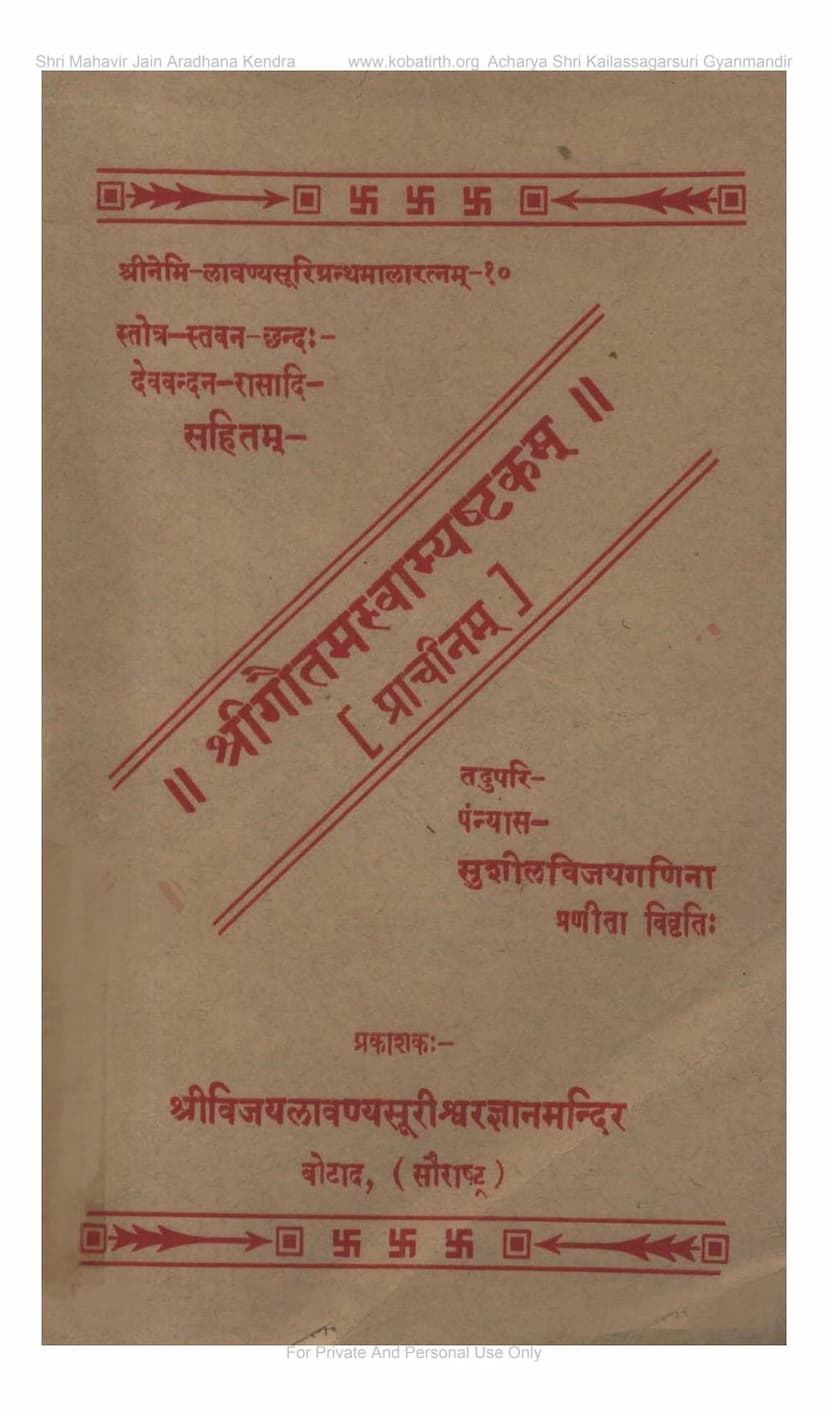Gautamswamyashtakam
Added to library: September 1, 2025

Summary
Here's a comprehensive summary of the Jain text "Gautamswamyashtakam" by Sushilvijay, based on the provided pages:
Book Title: Gautamswamyashtakam (श्रीगौतमस्वाम्यष्टकम्) Author: Sushilvijay (पंन्यास सुशीलविजय गणिना) Publisher: Shri Vijaylavanyasurishwar Gyanmandir, Botad (सौराष्ट्र) Catalog Link: https://jainqq.org/explore/020342/1
Overview:
The "Gautamswamyashtakam" is a devotional work dedicated to Gautam Swami, the chief disciple of Lord Mahavir, the 24th Tirthankar. The text is presented as an Ashtakam, meaning it consists of eight verses (shlokas) praising Gautam Swami. The book includes the original ancient verses and a commentary (vrutti) written by Panṇyāsa Sushilvijay Gani. The work is a tribute to the profound wisdom, devotion, and ascetic practices of Gautam Swami.
Key Content and Themes:
-
Gautam Swami's Identity and Virtues:
- Origin: Gautam Swami was originally known as Indrabhuti, the eldest of three learned brothers from the Gautam lineage, born in the village of Gobar (or Shekhar) to Vasubhuti and Prithvi.
- Intellectual Prowess: Indrabhuti and his brothers were unparalleled scholars in fourteen branches of knowledge, including grammar, logic, and philosophy. They were respected and sought-after teachers, imparting knowledge freely.
- Initial State: Despite their vast learning, they were proud and engrossed in Vedic rituals and philosophical debates, experiencing intellectual doubts on certain profound scriptural passages. Indrabhuti, in particular, was unable to fully grasp the meaning of a specific verse.
- Encounter with Lord Mahavir: While performing a Yagna (sacrifice), Indrabhuti and his brothers witnessed people leaving the ceremony to listen to Lord Mahavir's teachings. Driven by intellectual curiosity and a touch of pride, Indrabhuti approached Lord Mahavir to challenge him.
- Disillusionment and Acceptance: Lord Mahavir's discourse resolved Indrabhuti's intellectual doubts and impressed him with its clarity and depth. The pride of Indrabhuti melted away, and he, along with his brothers, humbly requested to become disciples of Lord Mahavir.
- First Ganadhar: Indrabhuti became the first Ganadhar (chief disciple and organizer of the spiritual community) of Lord Mahavir, renowned for his profound understanding of the Lord's teachings. He is credited with composing the Twelve Angas (scriptural texts) based on Lord Mahavir's sermon on the "Tripadi" (the three aspects of existence: origination, decay, and permanence).
- Asceticism and Powers (Labdhis): Gautam Swami dedicated his life to rigorous asceticism, often observing fasts (chhatth-chhatth). This penance granted him numerous extraordinary powers (labdhis), such as the "Akshin Mahānas Labbhi" (inexhaustible magical culinary power).
- Devotion and Respect: All beings, including gods and humans, revere Gautam Swami. His name is invoked during auspicious occasions and religious rituals. He is described as a source of immense bliss and a spiritual guide.
- Unwavering Devotion to Mahavir: Gautam Swami's immense love and devotion for Lord Mahavir were so profound that it prevented him from attaining Keval Jnana (omniscience) as long as Lord Mahavir was present.
- Attaining Keval Jnana: After Lord Mahavir's Nirvana, Gautam Swami, while returning from a mission, learned of the Lord's departure. Overwhelmed by grief, he then realized the nature of detachment and attained Keval Jnana. This event is celebrated annually.
- Role as Yuva Pradhan: After Lord Mahavir's Nirvana, the gods crowned Gautam Swami as the "Yuga Pradhan" (leader of the era).
- Lifespan and Liberation: Gautam Swami lived a significant life, spending 50 years as a householder, 30 years as an ascetic, and 12 years as a Kevali (omniscient being). He attained eternal liberation (Moksha).
-
The "Ashtakam" (Eight Verses):
- Each of the eight verses praises Gautam Swami for specific qualities and deeds.
- They highlight his divine origin, intellectual brilliance, his role in composing the scriptures, his asceticism, his miraculous powers, his exemplary devotion, his attainment of Keval Jnana, and his leadership after Lord Mahavir.
- The verses often end with the plea: "स गौतमो यच्छतु वाञ्छितं मे" (May that Gautam grant me my desires).
-
Commentary (Vrutti) by Sushilvijay:
- The commentary provides detailed explanations of each verse, elaborating on the meanings of words, philosophical concepts, and historical context related to Gautam Swami's life.
- It clarifies references to the Twelve Angas, the Fourteen Purvas, and the specific powers (labdhis) attained by Gautam Swami.
- The commentary also emphasizes the importance of devotion, knowledge, and righteous conduct, drawing parallels with other revered figures in Jainism.
-
Other Included Texts:
- Mangalacharan (Benedictory Verses): The text begins with auspicious verses invoking Lord Mahavir, Gautam Swami, and the spiritual gurus (Nemisurishwar and Lavanyasurishwar).
- Brief Biography of Gautam Swami: A biographical sketch provides a narrative of Gautam Swami's life, from his upbringing and intellectual pursuits to his enlightenment and liberation.
- Various Stotras, Stavan, Chand, Devvandan, and Rasas: The book contains numerous other devotional compositions in various poetic meters and musical styles, all celebrating Gautam Swami. These include:
- Sajhays (devotional songs)
- Chhand (poetic meters)
- Rasas (narrative poems, often sung)
- Chaitvavandans (prayers for circumambulation of temples)
- Chopais (quatrains)
- Author's Praise: The work also includes verses praising the commentator, Sushilvijay Gani, and his lineage of gurus, particularly Vijaylavanyasurishwar.
- Publisher and Printer Information: Details about the publisher, Shri Vijaylavanyasurishwar Gyanmandir, and the printer are provided.
- List of Other Works by Sushilvijay: A list of other books published by Sushilvijay is included, showcasing his prolific writing.
Significance:
The "Gautamswamyashtakam" is a significant work for Jain devotees, offering a deep appreciation for Gautam Swami's role in the propagation and preservation of Jain teachings. It serves as a source of inspiration for spiritual practice, intellectual pursuit, and unwavering devotion. The detailed commentary makes the text accessible and provides rich insights into Jain philosophy and history. The inclusion of various devotional forms allows for diverse modes of worship and remembrance of this revered spiritual figure.